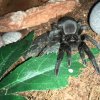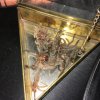Dovey
Arachnobaron
- Joined
- Apr 9, 2016
- Messages
- 537
Why is it that we don't spend more time talking about the fact that Grammostola pulcra spends a good portion of its life as a nondescript hairy brown spider with a skittish temperament? Honestly, I obtained this little girl from Pet Center USA in it's closing era, and more than once I began to wonder if, in spite of Paul's immaculate husbandry, somehow a cuckoo had gotten into the nest.
Can someone please reassure me that my sullen, nondescript patchy brown 3-inch adolescent will someday resemble the sleek velveteen beauties we see in tarantula guides?! They grow so quickly when they're tiny, but my experience has been that just about the time my pulcra hit its awkward phase, its growth slowed down to virtually nothing. I believe it's been nearly a year since its last molt. Is this typical? It has been on the bottom shelf of my spider cabinet. Might this slow its growth down there where the air is cooler? Would upping the ambient temperature move things along at a brisker pace? Because at this point, I'm ready to send this standoffish little rugrat to camp!
Can someone please reassure me that my sullen, nondescript patchy brown 3-inch adolescent will someday resemble the sleek velveteen beauties we see in tarantula guides?! They grow so quickly when they're tiny, but my experience has been that just about the time my pulcra hit its awkward phase, its growth slowed down to virtually nothing. I believe it's been nearly a year since its last molt. Is this typical? It has been on the bottom shelf of my spider cabinet. Might this slow its growth down there where the air is cooler? Would upping the ambient temperature move things along at a brisker pace? Because at this point, I'm ready to send this standoffish little rugrat to camp!
Attachments
-
1.5 MB Views: 251





